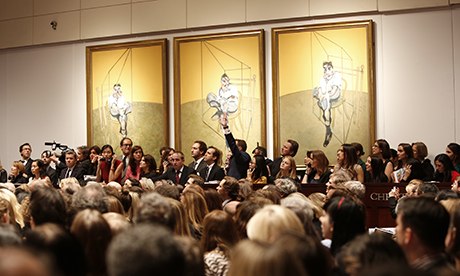 |
| Picture: Guardian |
Christie's CEO Steven Murphy came across as a complete muppet in a recent FT interview (18 November 2013 p.18 and video here). He asserts that there's no bubble because each work in their NY sale "reached their proper and expected value". So, there's no bubble because works are selling for their 'proper' value. Which, in a triumph of circular reasoning, is the same as their auction price. Oddly enough that's not always the same as Christie's estimates, but definitely for extremely reasonable and non-bubbly prices. Murphy claims that "the number of buyers around the world who are intrigued and want to invest and want to own and live with this art, is just becoming exponential", which proves mainly that Murphy doesn't know what 'exponential' means. We know that CEOs have to act as salesmen, but this is demeaning.
Maybe Murphy is getting excited because his rival Sotheby's continues to be battered in the press. Sotheby's' star auctioneer and head of Contemporary Art Tobias Meyer has just left the firm, accompanied by bland statements from both sides. I'm not sure it's good news for Christie's. The pressure on Sotheby's to ensure it snags the big game in next season's Contemporary and Impressionist & Modern sales will now be even greater. And having lost Meyer, it will be competing even more on price and guarantees. That's going to drive down margins and increase risk across the industry.
The media focus on the big-ticket items, using record-breaking prices and highest sale totals as a proxy for judging the relative success of Sotheby's and Christie's. But the biggest lots are not always good for the bottom line, because the auctioneers have to offer such good terms to sellers - a point that Sotheby's beleaguered CEO has rightly emphasised. It means there can be a big gap between media perception of success and actual financial performance.
As an antidote to these flimsy claims, try Felix Salmon's analysis at Reuters, which claims there's a 'bubble' but not a 'speculative bubble', which is different. I suspect he's right, although I'm a bit more bullish on prospects for the overall market. Certain areas, like contemporary Chinese art, seem madly over-priced by any reasonable yardstick. But I would be cautious of shorting the likes of Koons just because I think they're ridiculous. Never underestimate the shallowness and credulity of the modern billionaire.
I also liked this important technical article on art as investment, which Markus Stolz shared. It shows that evidence about art being a great investment is distorted because art that appreciates in value is most likely to be sold. So the research that says art is a great investment is based on analysis only of the winners. That accords with evidence showing that people are inclined to sell stocks that have performed well, but keep those that have done badly in desperate hope that they'll recover their value (the 'sunk costs fallacy'). I try to be especially sceptical when looking at research that accords with my prejudices (I've always thought investing in art is a fools' game), but this really does look robust.
The question you should always ask yourself when investing is what you can know that no one else knows. The answer to that, for almost everyone almost all the time, is nothing. Even professionals fail to outperform the market, because the market price already reflects the consensus of knowledge between all buyers and sellers. You might think that the art market will continue to rise because so much new wealth is being created in emerging markets, but everyone else knows that too - so that expectation is already included in the current price. This idea - a version of the 'efficient market hypothesis' - is commonplace in finance. The fact that it's not widely recognised in the art world is a reflection of the more anecdotal evidence supplied in favour of investment in art. I like to think that a lot of art investors are really consumers who buy what they like, but try to rationalise their extravagance.
No comments:
Post a Comment